- Home
- John D. MacDonald
Murder in the Wind
Murder in the Wind Read online
Praise for John D. MacDonald
“My favorite novelist of all time.”
—DEAN KOONTZ
“For my money, John D. MacDonald’s Travis McGee is one of the great characters in contemporary American fiction—not crime fiction; fiction, period—and millions of readers surely agree.”
—The Washington Post
“MacDonald isn’t simply popular; he’s also good.”
—ROGER EBERT
“MacDonald’s books are narcotic and, once hooked, a reader can’t kick the habit until the supply runs out.”
—Chicago Tribune Book World
“Travis McGee is one of the most enduring and unusual heroes in detective fiction.”
—Baltimore Sun
“John D. MacDonald remains one of my idols.”
—DONALD WESTLAKE
“A dominant influence on writers crafting the continuing series character.”
—SUE GRAFTON
“The Dickens of mid-century America—popular, prolific and … conscience-ridden about his environment … a thoroughly American author.”
—The Boston Globe
“It will be for his crisply written, smoothly plotted mysteries that MacDonald will be remembered.”
—USA Today
“MacDonald had the marvelous ability to create attention-getting characters who doubled as social critics. In MacDonald novels, it is the rule rather than the exception to find, in the midst of violence and mayhem, a sentence, a paragraph, or several pages of rumination on love, morality, religion, architecture, politics, business, the general state of the world or of Florida.”
—Sarasota Herald-Tribune
BY JOHN D. MACDONALD
The Brass Cupcake
Murder for the Bride
Judge Me Not
Wine for the Dreamers
Ballroom of the Skies
The Damned
Dead Low Tide
The Neon Jungle
Cancel All Our Vows
All These Condemned
Area of Suspicion
Contrary Pleasure
A Bullet for Cinderella
Cry Hard, Cry Fast
You Live Once
April Evil
Border Town Girl
Murder in the Wind
Death Trap
The Price of Murder
The Empty Trap
A Man of Affairs
The Deceivers
Clemmie
Cape Fear (The Executioners)
Soft Touch
Deadly Welcome
Please Write for Details
The Crossroads
The Beach Girls
Slam the Big Door
The End of the Night
The Only Girl in the Game
Where Is Janice Gantry?
One Monday We Killed Them All
A Key to the Suite
A Flash of Green
The Girl, the Gold Watch & Everything
On the Run
The Drowner
The House Guest
End of the Tiger and Other Stories
The Last One Left
S*E*V*E*N
Condominium
Other Times, Other Worlds
Nothing Can Go Wrong
The Good Old Stuff
One More Sunday
More Good Old Stuff
Barrier Island
A Friendship: The Letters of Dan Rowan and John D. MacDonald, 1967–1974
The Travis McGee Series
The Deep Blue Good-by
Nightmare in Pink
A Purple Place for Dying
The Quick Red Fox
A Deadly Shade of Gold
Bright Orange for the Shroud
Darker Than Amber
One Fearful Yellow Eye
Pale Gray for Guilt
The Girl in the Plain Brown Wrapper
Dress Her in Indigo
The Long Lavender Look
A Tan and Sandy Silence
The Scarlet Ruse
The Turquoise Lament
The Dreadful Lemon Sky
The Empty Copper Sea
The Green Ripper
Free Fall in Crimson
Cinnamon Skin
The Lonely Silver Rain
The Official Travis McGee Quizbook
Murder in the Wind is a work of fiction. Names, characters, places, and incidents either are the product of the author’s imagination or are used fictitiously. Any resemblance to actual persons, living or dead, events, or locales is entirely coincidental.
2013 Random House eBook Edition
Copyright © 1956 by John D. MacDonald Publishing, Inc.
Introduction copyright © 2013 by Dean Koontz
All rights reserved.
Published in the United States by Random House Trade Paperbacks, an imprint of The Random House Publishing Group, a division of Random House, Inc., New York.
RANDOM HOUSE TRADE PAPERBACKS and colophon are trademarks of Random House, Inc.
eISBN: 978-0-307-82697-8
www.atrandom.com
Cover design: Joe Montgomery
v3.1
Contents
Cover
Other Books by This Author
Title Page
Copyright
Introduction
Author’s Note
Chapter 1
Chapter 2
Chapter 3
Chapter 4
Chapter 5
Chapter 6
Chapter 7
Chapter 8
Chapter 9
Chapter 10
Chapter 11
Chapter 12
Chapter 13
Chapter 14
Chapter 15
Chapter 16
Chapter 17
About the Author
The Singular John D. MacDonald
Dean Koontz
When I was in college, I had a friend, Harry Recard, who was smart, funny, and a demon card player. Harry was a successful history major, while I passed more time playing pinochle than I spent in class. For the three and a half years that I required to graduate, I heard Harry rave about this writer named John D. MacDonald, “John D” to his most ardent readers. Of the two of us, Harry was the better card player and just generally the cooler one. Consequently, I was protective of my position, as an English major, to be the better judge of literature, don’t you know. I remained reluctant to give John D a look.
Having read mostly science fiction, I found many of my professors’ assigned authors markedly less exciting than Robert Heinlein and Theodore Sturgeon, but I was determined to read the right thing. For every Flannery O’Connor whose work I could race through with delight, there were three like Virginia Woolf, who made me want to throw their books off a high cliff and leap after them. Nevertheless, I continued to shun Harry’s beloved John D.
Five or six years after college, I was a full-time writer with numerous credits in science fiction, struggling to move into suspense and mainstream work. I was making progress but not fast enough to suit me. By now I knew that John D was widely admired, and I finally sat down with one of his books. In the next thirty days, I read thirty-four of them. The singular voice and style of the man overwhelmed me, and the next novel I wrote was such an embarrassingly slavish imitation of a MacDonald tale that I had to throw away the manuscript.
I apologized to Harry for doubting him. He was so pleased to hear me proclaiming the joys of John D that he only said “I told you so” on, oh, twenty or thirty occasions.
Over the years, I have read every novel by John D at least three times, some of them twice that often. His ability to evoke a time and place—mostly Florida but also the industrial Midwe
st, Las Vegas, and elsewhere—was wonderful, and he could get inside an occupation to give you the details and the feel of it like few other writers I’ve ever read. His pacing was superb, the flow of his prose irresistible, and his suspense watch-spring tight.
Of all his manifest strengths as a writer, however, I am most in awe of his ability to create characters who are as real as anyone I’ve met in life. John D sometimes paused in the headlong rush of his story to spin out pages of background on a character. At first when this happened, I grumbled about getting on with the story. But I soon discovered that he could make the character so fascinating that when the story began to race forward again, I wanted it to slow down so I could learn more about this person who so intrigued and/or delighted me. There have been many good suspense novelists in recent decades, but in my experience, none has produced characters with as much humanity and truth as those in MacDonald’s work.
Like most who have found this author, I am an admirer of his Travis McGee series, which features a first-person narrator as good as any in the history of suspense fiction and better than most. But I love the standalone novels even more. Cry Hard, Cry Fast. Where Is Janice Gantry? The Last One Left. A Key to the Suite. The Drowner. The Damned. A Bullet for Cinderella. The Only Girl in the Game. The Crossroads. All These Condemned. Those are not my only favorites, just a few of them, and many deal with interesting businesses and occupations. Mr. MacDonald’s work gives the reader deep and abiding pleasure for many reasons, not the least of which is that it portrays the contemporary life of his day with as much grace and fidelity as any writer of the period, and thus it also provides compelling social history.
In 1985, when my publisher, Putnam, wanted to send advance proof copies of Strangers to Mr. MacDonald among others, I literally grew shaky at the thought of him reading it. I suggested that they shouldn’t send it to him, that, as famous and prolific as he was, the proof would be an imposition on him; in truth, I feared that he would find the novel unsatisfying. Putnam sent it to him anyway, and he gave us an enthusiastic endorsement. In addition, he wrote to me separately, in an avuncular tone, kindly advising me how to avoid some of the pitfalls of the publishing business, and he wrote to my publisher asking her to please carefully consider the packaging of the book and not condemn it to the horror genre. She more or less condemned it to the genre anyway, but I took his advice to heart.
In my experience, John D. MacDonald, the man, was as kind and thoughtful as his fiction would lead you to believe that he must be. That a writer’s work accurately reflects his soul is a rarer thing than you might imagine, but in his case, the reflection is clear and true. For that reason, it has been a special honor, in fact a grace, to be asked to write this introduction.
Reader, prepare to be enchanted by the books of John D. MacDonald. And Harry, I am not as much of an idiot as I was in years gone by—though I know you won’t let me get away with claiming not to be to any degree an idiot anymore.
Author’s Note
Certain minor liberties have been taken with the geography of the Florida West Coast. There is a Waccasassa River and a bridge over it on Route 19. However, there is no bypass road nor wooden bridges. And, of course, the old house does not exist.
To anyone who might be skeptical of the possibility of Route 19 being inundated during a hurricane, it can be pointed out that this highway was under water in the vicinity of Yankeetown and Withlacoochee Bay during the 1950 hurricane known in the area as the Cedar Key Hurricane. Residents of Yankeetown were evacuated because of fear that the Florida Power and Light Company dam might burst. By the time it became apparent that it would have been a far better idea to evacuate the residents of Cedar Key, Route 24 was under water and impassable.
Though the chance is statistically remote, there need only be the unfortunate conjunction of hurricane path and high Gulf tide to create coastal death and damage surpassing the fictional account in this book.
1
Except for a slow oily swell, the Caribbean Sea was flat and quiet and eerily still on the morning of Sunday, October fourth. Sarrensen, Captain of the Swedish motor vessel Altagarde, had a late solitary breakfast in his cabin. He had slept poorly and his digestion, never reliable, was bothering more than usual on this trip.
He was a small quiet remote man with a soured expression and a reputation for reliability. It was after nine when he climbed to the bridge, nodded to the Third, checked the log and the heading, and walked out onto the port wing of the bridge. He put short blunt fingers inside his belt and pressed against the area of a stomach cramp and looked at the sea world around him. He did not like the look of the day. The sky, though cloudless, was too pale. The sun was fierce and white. The flat sea had the look of a blue mirror on which warm breath has been blown, misting it. It was impossible to see where the sea ended and the sky began.
The immediate destination of the Altagarde was Havana, about five hundred nautical miles away. He looked at his gold watch and looked at the sky and estimated their time of arrival at nine on Monday evening. But he did not like the look of the day.
He walked in and stood by the Third and looked at the barometer. Low. Not dangerously low, but significantly low.
“Still slipping,” he said.
“Not much. It’s pretty steady. Been about where it is since six. I told Sparks to pick up all the weather he can.”
“Good.”
Sarrensen walked out onto the starboard wing. He leaned his arms on the rail and gave a small grunt of pain at an especially sharp stomach twinge. There was no sense of motion in the Altagarde. It moved smoothly across the featureless sea, rocking but slightly to the long slow swells. The wake was a ruled line behind her. Through the soles of his shoes, and in the tremor of the rail, Sarrensen felt the deep and comforting cha-gah, cha-gah, cha-gah of the turning shaft.
He took out his watch and timed the swells. Somewhere between five and six a minute. In these tropical waters the norm was eight. A hurricane reduces the incidence of the swells, and sends them radiating out in all directions from the center of the storm, moving sometimes as fast as eighty miles an hour, moving far ahead of the storm, carrying a sure warning to primitive peoples of the islands. He carefully noted the direction from which the swells were coming in relation to the compass direction of the ship. Then he went below.
At three o’clock in the afternoon on Sunday, October fourth, the wind began. It came out of the east. It was a fitful, elusive, teasing wind. It riffled the misted blue of the sea. Infrequent gusts, almost as sturdy as a squall, pressed against the steel flank of the Altagarde and she would roll in response. Sarrensen went out onto the starboard wing. Streamers of high cirrus cloud radiated from a point on the southeast horizon. Sarrensen faced directly into the wind. It was a rule of thumb, as old as the half-rule of man over the sea, that in the counter-clockwise winds of hurricanes in the northern hemisphere, when you face into the wind your right hand points at the storm center. It gave new confirmation of the direction the swells had told him. It was far from him, behind him. Knowing the location of it stilled some of the uneasiness he had felt all day.
The Altagarde radioed her position and reported the estimated position of a tropical disturbance. The report was relayed to Miami where it became a partial confirmation of previous reports. At the time the report was received the tropical disturbance was termed an area of suspicion. By five-twenty on Monday evening the first search aircraft entered the area and radioed back sufficient information so that by the time of the six o’clock news broadcasts the disturbance had been dignified by awarding it the name of Hilda. It was the eighth storm of the season.
But it did not begin, as though on signal, with the designation of a name. It began earlier, and in a timeless way. Flat sea baking under a tropic sun. Water temperature raised by the long summer. The still air, heated by sun and sea, rising endlessly, creating an area of low pressure to be filled by air moving in from all sides to rise in turn.
But these factors alone coul
d not create hurakan. There must be added the thousand miles an hour spinning of the earth itself. The warm currents rose high, and there was the effect of drag, the way a speeding car can raise dust devils along the dry shoulder of a highway. The spin began slowly at first, very slowly. At times it died out and then began again. It covered a great area, and the winds spun slowly at the rim of the wheel, but more quickly toward the hub. It gathered momentum. It began to gain in force and speed and it seemed to feed upon itself, to gain greater life force as it began to move slowly from the area where it began, began to move in the long curved path that would carry it in a northwesterly direction until, on some unknown day in the future it would at last die completely away.
As it moved it pushed the hot moist air ahead of it, and the moisture of that air, cooled by height, fell as heavy drenching rain.
Man spoke across the empty air above the sea. The location, direction, velocity were charted. Man warned man. Prepare for this violence that is now aimed at you.
But the other living creatures were warned in other ways. They were affected by the barometric changes. Birds turned away from the path of the storm. On small keys legions of fiddler crabs marched inland, ponderous claws raised. The fish ceased feeding and moved at lower levels.
By eight o’clock on Monday night the wind velocities near the center of the disturbance were measured at eighty miles an hour. The hurricane had begun its lateral movement At from fifteen to eighteen miles an hour it moved north-northwest toward the long island of Cuba. It was carefully watched and plotted.
In Miami, a city wise in the ways of hurricanes, sucker disks were fastened to the big shopwindows and thumb screws tightened the disks to rigid metal uprights that would keep the windows from picking up the vibration that would shatter them. Men climbed on roofs and put additional guy wires on television aerials. The sale of radio batteries was brisk. Drinking water was stored. Gasoline stoves were taken out of storage. There was a flavor of excitement in the city, even of amiability, as man accepted this immediate and understandable tension in fair exchange for the tiresome tensions of his everyday life.

 More Good Old Stuff
More Good Old Stuff The Long Lavender Look
The Long Lavender Look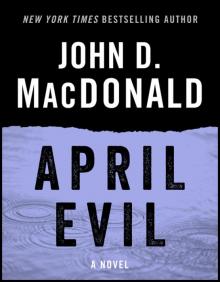 April Evil
April Evil I Could Go on Singing
I Could Go on Singing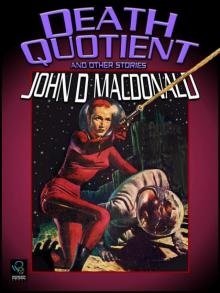 Death Quotient and Other Stories
Death Quotient and Other Stories Murder in the Wind
Murder in the Wind The Quick Red Fox
The Quick Red Fox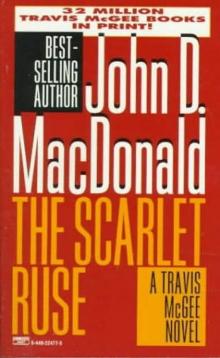 The Scarlet Ruse
The Scarlet Ruse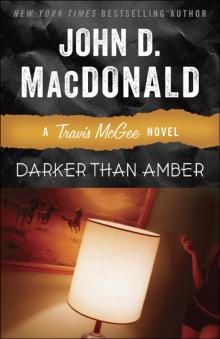 Darker Than Amber
Darker Than Amber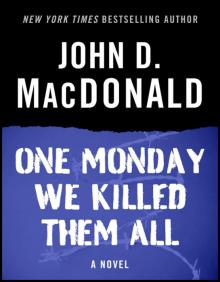 One Monday We Killed Them All
One Monday We Killed Them All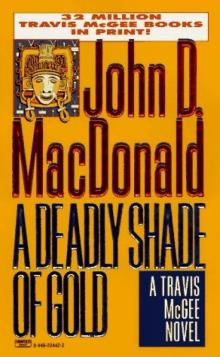 A Deadly Shade of Gold
A Deadly Shade of Gold The Girl, the Gold Watch and Everything
The Girl, the Gold Watch and Everything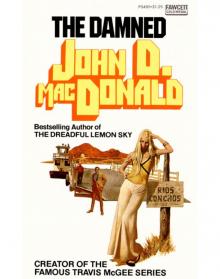 The Damned
The Damned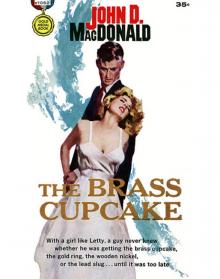 The Brass Cupcake
The Brass Cupcake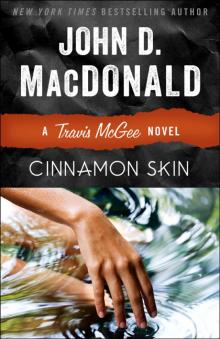 Cinnamon Skin
Cinnamon Skin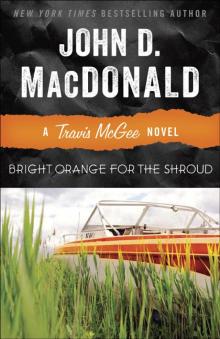 Bright Orange for the Shroud
Bright Orange for the Shroud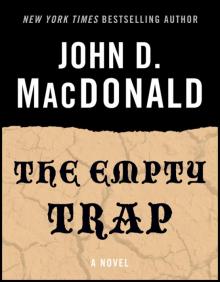 The Empty Trap
The Empty Trap Where Is Janice Gantry?
Where Is Janice Gantry? Soft Touch
Soft Touch Condominium
Condominium The Neon Jungle
The Neon Jungle Girl In The Plain Brown Wrapper
Girl In The Plain Brown Wrapper All These Condemned
All These Condemned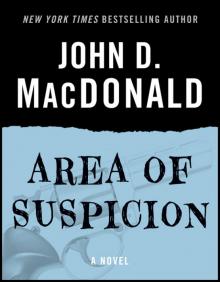 Area of Suspicion
Area of Suspicion The Crossroads
The Crossroads The Good Old Stuff
The Good Old Stuff The Girl in the Plain Brown Wrapper
The Girl in the Plain Brown Wrapper The Beach Girls
The Beach Girls A Purple Place For Dying
A Purple Place For Dying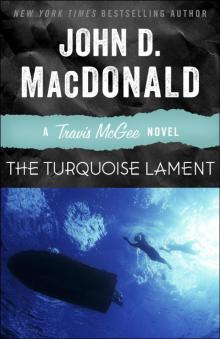 The Turquoise Lament
The Turquoise Lament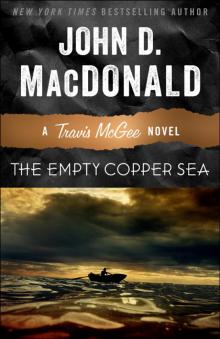 The Empty Copper Sea
The Empty Copper Sea You Live Once
You Live Once The House Guests
The House Guests A Bullet for Cinderella
A Bullet for Cinderella A Man of Affairs
A Man of Affairs A Key to the Suite
A Key to the Suite Please Write for Details
Please Write for Details Free Fall in Crimson
Free Fall in Crimson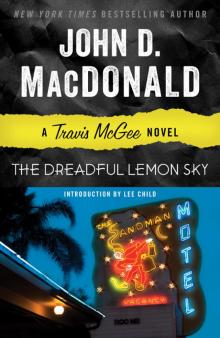 The Dreadful Lemon Sky
The Dreadful Lemon Sky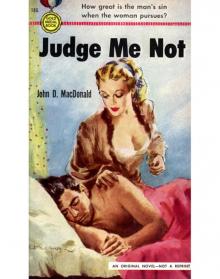 Judge Me Not
Judge Me Not The Price of Murder
The Price of Murder On the Run
On the Run The Deep Blue Good-Bye
The Deep Blue Good-Bye The Only Girl in the Game
The Only Girl in the Game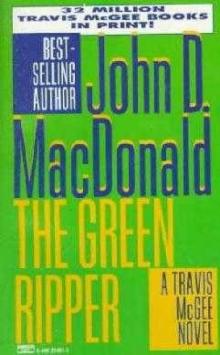 The Green Ripper
The Green Ripper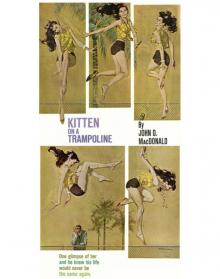 Kitten on a Trampoline
Kitten on a Trampoline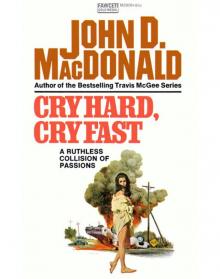 Cry Hard, Cry Fast
Cry Hard, Cry Fast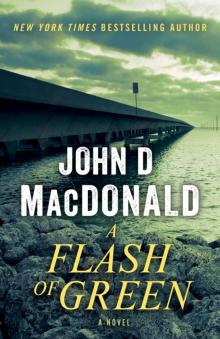 A Flash of Green
A Flash of Green The End of the Night
The End of the Night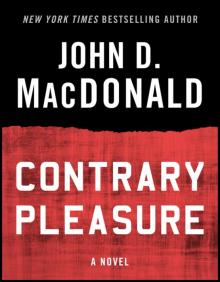 Contrary Pleasure
Contrary Pleasure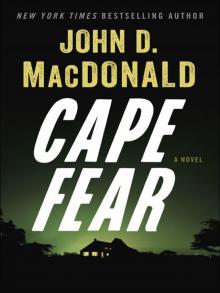 Cape Fear
Cape Fear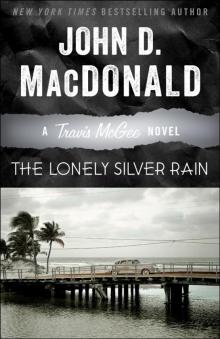 The Lonely Silver Rain
The Lonely Silver Rain Slam the Big Door
Slam the Big Door The Last One Left
The Last One Left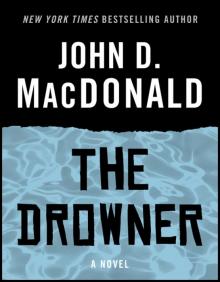 The Drowner
The Drowner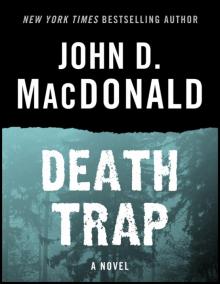 Death Trap
Death Trap Wine of the Dreamers: A Novel
Wine of the Dreamers: A Novel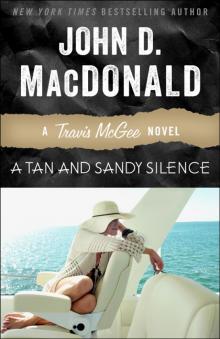 A Tan and Sandy Silence
A Tan and Sandy Silence One Fearful Yellow Eye
One Fearful Yellow Eye Border Town Girl
Border Town Girl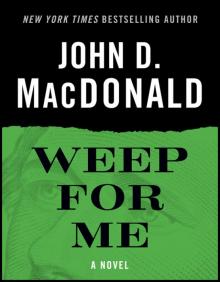 Weep for Me
Weep for Me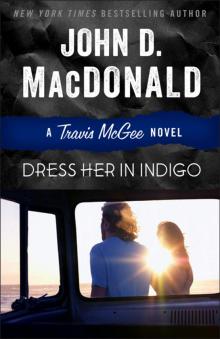 Dress Her in Indigo
Dress Her in Indigo Deadly Welcome
Deadly Welcome Cancel All Our Vows
Cancel All Our Vows Murder for the Bride
Murder for the Bride End of the Tiger
End of the Tiger